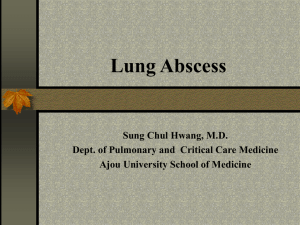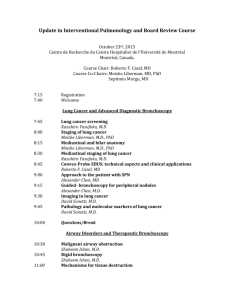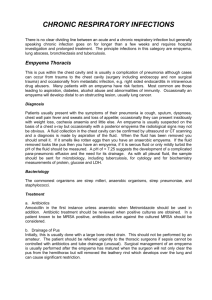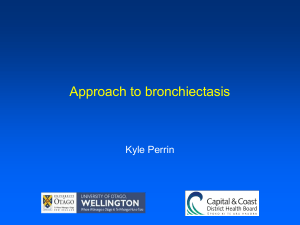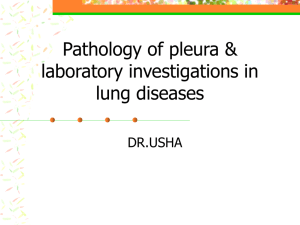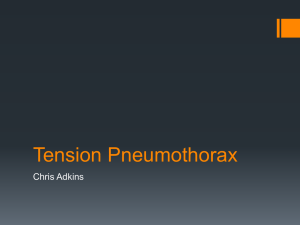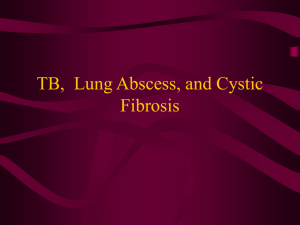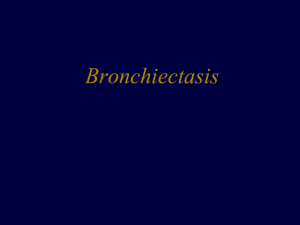Chronic-Lung
advertisement
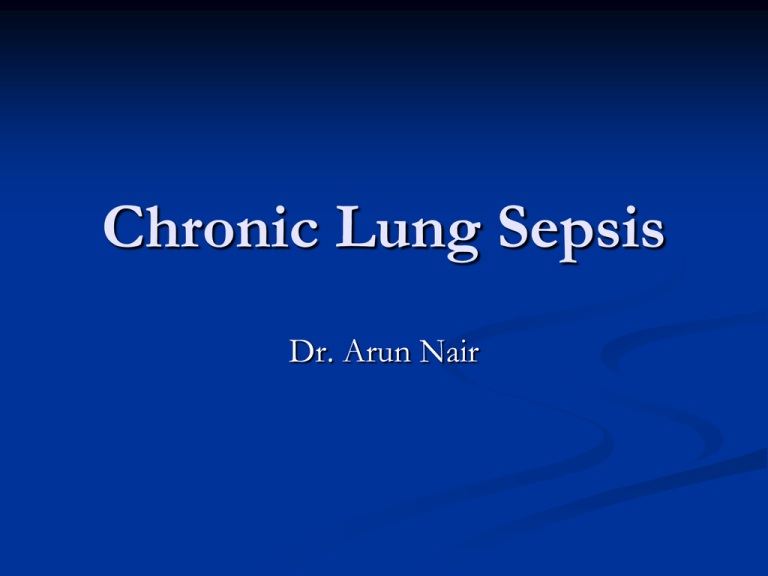
Chronic Lung Sepsis
Dr. Arun Nair
Includes
Lung Abscess
Empyema
Bronchiectasis
Lung Abscess
Lung Abscess
Definition & overview
Cavitating, infected, necrotic lesion of lung parenchyma
Several possible causes
Single or Multiple
Small <2cm or large
Most secondary to aspiration of oropharyngeal secretions
Mixed growth of organisms, including anaerobes
Causes
Aspiration
Bronchial obstruction {Tumour / Foreign Body}
Pneumonia
Blood borne infection
Transdiaphragmatic spread
Differential Diagnosis
Cavitating tumour
Infected bronchial cyst/bulla
Localised saccular bronchiectasis
Aspergilloma
Wegeners granulomatosis
Hydatid cyst
Gas-fluid level in oesophagus, stomach or bowel
Microbiology
Anaerobes: Peptostreptococcus, Prevotella, Bacteroides
spp (usually not B. fragilis), and Fusobacterium spp.
Staph Aureus, Klebsiella, Strep Milleri
Strep Pneumonia, gram negative bacilli
M.Tuberculosis
Fungi
Clinical Features
Most patients present over several weeks
Malaise, weight loss, fever
Cough with copious purulent sputum
Can be associated with haemoptysis
Toxic features prominent in patients with pneumonia or blood
borne infection
Clubbing often seen
Investigations
CXR: PA & Lateral
CT Thorax
Sputum & Blood Cultures
FBC, CRP, ESR, Serological tests
Treatment
AUGMENTIN
AMOXIXCILLIN & METRONIDAZOLE
CLINDAMYCIN
Physiotherapy & postural drainage
Trans Thoracic/ endoscopic drainage for large
abscess
Duration of ABx:
3- 4 weeks
Empyema
Pus in pleural space
Sequelae of a complicated parapneumonic
infection, when bacteria invade pleural space
Uncomplicated
Complicated
Frank Empyema
Pathogenesis
Uncomplicated parapneumonic effusion —
occurs when the lung interstitial fluid increases
during pneumonia, and is characterized by
"exudative" pleural fluid chemistries and an
influx of neutrophils into the pleural space.
resolve with resolution of the pneumonia.
Complicated Parapneumonic
effusion
occurs when there is persistent bacterial invasion of the
pleural space.
Results in pleural fluid acidosis (anaerobic utilization).
Lysis of neutrophils increases the LDH concentration
in the pleural fluid to values often in excess of 1000
IU/L.
Complicated parapneumonic effusions are often sterile
because bacteria can be cleared rapidly from the pleural
space. (Loculation )
Thoracic Empyema
Formation of empyema is the third stage and is
characterized by bacterial organisms seen on
gram stain or the aspiration of pus on
thoracentesis.
A positive culture is not required for diagnosis.
Bacteriology
Mixed bacterial flora
Anaerobic bacteria in 36-76%
Streptococcus milleri, Staphylococcus aureus, and
Enterobacteriaceae.
Patients with diabetes mellitus are at increased risk of
empyema secondary to Klebsiella pneumoniae.
S. pneumoniae and S. aureus (including methicillinresistant organisms) are the leading causative bacteria in
children with empyema.
Pleural fluid analysis
Pus
Ph <7.2
Glucose < 60 mg/dl
LDH>1000 IU/L
WBC>15/nl
Imaging
CXR
CT
USG
Signs favouring empyema
Evidence of lung compression
Smooth margins
Blunt angle with chest wall
Dissection of thickened visceral and parietal
pleura
Treatment
Pleural drainage
Chest Drain
Thoracoscopy
Antibiotics
Fibrinolytics: No convincing benefit
Bronchiectasis
Abnormal permanent dilatation of one or more
bronchi
Poor mucous clearance
Chronic bacterial infection & inflammation
Long term lung damage
Types
Saccular /Cystic
Cylindrical
Varicose
Saccular Bronchiectasis
Large baloon like
dilatation from severe
loss of bronchial wall
Assoc with severe lung
infections, large sputum
volumes, finger clubbing
Cylindrical Bronchiectasis
Varicose Bronchiectasis
Causes
Congenital {defective bronch wall/ sequesteration}
Post infective {TB, Pertussis, NTM, ABPA}
Airway obstruction (eg, foreign body aspiration)
Defective host defenses{ CVID, HIV, phagaocyte dysfn
Inflammatory pneumonitis {gastric aspiration, toxic gas inhalation}
Abnormal mucociliary clearance {Primary Ciliary Dyskinesia, cystic fibrosis,
Young's syndrome
Rheumatic and systemic diseases, cigarette smoking, Chronic Bronchitis.
Symptoms
Cough (98 percent of patients)
Daily sputum production (78 percent)
Dyspnoea (62 percent),
Rhinosinusitis (73 percent)
Hemoptysis (27 percent)
and recurrent pleurisy (20 percent).
Physical Findings
Crackles (75 percent)
Wheezing (22 percent) were common,
Digital clubbing occurred in only 2 percent of
patients.
Pathophysiology
Induction of bronchiectasis requires two factors
An infectious insult
Impaired drainage, airway obstruction, or a
defect in host defense
Recurrent infection leads to further scarring,
obstruction, and distortion of the airways, as
well as temporary or permanent damage to the
lung parenchyma.
Diagnostic workup
The following LAB studies should be part of the
initial evaluation of a patient with bronchiectasis:
A complete blood count with differential
Immunoglobulin quantitation to measure the
levels of the immunoglobulins IgG, IgM, and
IgA
Sputum culture and smear for bacteria,
mycobacteria, and fungi
Imaging
CXR radiographic
findings include linear
atelectasis, dilated and
thickened airways (ie,
tram or parallel lines,
ring shadows on cross
section) and irregular
peripheral opacities that
may represent
mucopurulent plugs.
High Resolution CT Thorax
Airway dilatation
Bronchial wall thickening
Lack of tapering
mucopurulent plugs or
debris accompanied by
post-obstructive air
trapping (tree-in-bud)
Distribution
A central (perihilar) distribution is suggestive of
ABPA.
predominant upper lobe distribution is
characteristic of cystic fibrosis
middle and lower lobe distribution is consistent
with PCD
lower lobe involvement is typical of idiopathic
bronchiectasi
Spirometry
Obstructive picture common
Frequently isolated pathogens on CULTURE
include Hemophilus influenzae, Pseudomonas
aeruginosa (especially mucoid types), and, less
frequently, Streptococcus pneumoniae
Treatment
Postural drainage
Based on sputum culture & sensitivity
Non-Pseudomonas organism:
Amoxicillin: 1gm TID 14 days
Augmentin 625 mg TID 14 days
Doxycyline 100mg BD 14 days
Ciprofloxacin 750 mg BD 14 days (Pseudomonas)
Ceftazidime 2gm TID 7-14 days (Pseudomonas)
Nebulised Tobramycin (Pseudomonas)
END
Signs favouring lung abscess
Spherical shape with irregular and thick wall
Absence of lung compression
Sharp angle with chest wall
Vasculature around abscess
